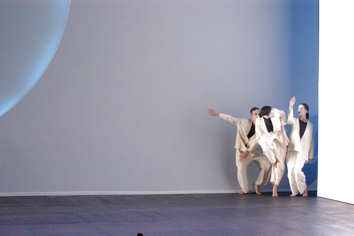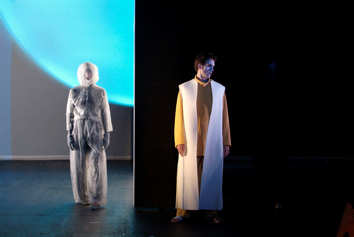|
|
|

Editorial
Board
London Editor:
(London UK)
Melanie
Eskenazi
Regional Editor:
(UK regions and Worldwide)
Bill
Kenny
Webmaster:
Bill
Kenny
Music Web Webmaster:
Len
Mullenger



|
MusicWeb is a
subscription-free site
Clicking Google adverts on our pages helps us keep it that way
Seen
and Heard International Opera Review
Claudio Monteverdi, L'Orfeo:
Soloists of the Festival de Aix-en-Provence,
soloists of the Académie européeen de musique,
English Voices chorus, Trisha Brown Dance Company,
Concerto Vocale orchestra, René Jacobs conductor,
production from the Théâtre Royale de la Monnaie
1998, Aix-en-Provence, France. 15.7.2007 (MM)

The more famous contemporary choreographers arrive
from time to time in the South of France to ply
their craft. Pina Bausch inaugurated the Stéphane
Lissner regime at the Aix Festival ten years ago
with an indifferent, ultimately boring
Bluebeard's Castle, more recently Sasha Walz
brought her splendid L'Orfeo to
Montpellier, water tanks and all. Some years back
Trisha Brown's troop of dancers showed up in the
Cour d'Honneur of the Avignon Festival, enervating
a small audience that fled noisily when it had had
its fill of stomping and running.
But not so this Trisha Brown Orfeo at the
Aix Festival where the audience sat entranced for
two hours of mushy Monteverdi. Danced rather more
effectively than sung, this performance was driven
primarily by spectacular stagecraft, brilliant
minimalism and the indefatigable genius of
Monteverdi. It is no surprise that there was a
pleased audience as this Orfeo was hardly a
new trick, having proved itself ten years ago at
Bernard Foccroulle's Théatre Monnaie.
Swiss designer Toland
Aeschlimann provided a huge white box to
enclose the action. The front wall, then the
back wall held the same huge open circle on which
Trisha Brown's flying dancer, La Musica, became
the dynamic suspended decorations of a Renaissance
ceiling. A sidewall moved forward revealing the
third act blackness of Hell and its guard Caronte,
its fatal movement heroically resisted by Trisha
Brown's Orfeo. Then Euridice was turned to stone,
the enigmatic tragedy was achieved, and Hell
receded. Eventually the opposite side moved
onstage motivating Orfeo's apotheosis by pushing
his assent onto Aeschlimann's perfect, heavenly
circle. These bold scenographic statements
matched Monteverdi's mythology perfectly.

Ed Lyon as Orfeo
Trisha Brown's nymphs and swains, uniformly
clothed in movement friendly loose white pant
suits, enlivened the pastoral first act while
Orfeo, loosely suited in energetic yellow,
expressed his happiness. Monteverdi's Euridice
appears only momentarily; here in an elaborate,
abstracted short gown in saturated blue, her
subsequent death recounted by an emerald green
nymph, La Messagiera. The infernal spirits
wrapped in cowled black robes rolled on the floor
making the river Styx come alive with these
unhappy souls marooned in Hell. These strong
shapes and colors of Aeschlimann's minimalist
costumes attained status as universal symbols of
the Christian and pagan tensions that preoccupied
the Renaissance man.
There was little distinction in the movements and
dynamism of Trisha Brown's ten dancers, the eleven
young chorus singers comprising English Voices,
and the twelve young soloists of the Aix
Festival's Académie européenne de musique.
Trisha Brown's dance language is urgent and
minimal, as is Monteverdi's music. Movements are
simple elaborations of ordinary human motions that
are quickly executed while moving in concert with
other dancers in and out of larger graphic
shapes.
There were two professional singers in the cast,
the Orfeo of Ed Lyon (appearing in three of the
six performances) and the Musica/Messagiera/Speranza
of Marie-Claude Chappuis. Mr. Lyon's Orfeo was
splendidly sung and choreographically superbly
rendered, his lengthy monologues enacted in
abrupt, abstracted physical actions, a strongly
defined Monteverdian musical word often
underscored with a single powerful body movement.
Marie-Claude Chappuis's performance was less
effective. Her La Musica was vocally insecure,
the highly dramatic Messagiera speech was vocally
and histrionically tepid, though her movements --
arms and hands choreographically placed in
precise, unmoving attitudes that underscored the
sense of a verse -- were convincing.
The exploits of the mythological Orfeo, and here
his courage to confront hell itself, are nothing
if not heroic. Not less so are the vocal and
histrionic exploits Monteverdi requires of his
Orfeo. Mr. Lyon is a light tenor voice, a slender
young swain, who for all his artistry cannot
physically be Orfeo. Ms. Chappuis is an
accomplished, young early-music singer who
possesses neither the adequate vocal size nor the
physical presence or charisma to fill an opera
theater. The same may be said with some few
exceptions of the young singers of the Académie
européenne de musique.
Yet this was Ms. Brown's evening of highly
theatrical movement in Mr. Aeschlimann's brilliant
setting, an artistic accomplishment of
considerable stature. Even the inherent
difficulty of the piece, the seemingly extraneous
apotheosis of the fifth act, was overcome, the
physicality of the scenography and choreography
making a dramatic crescendo into the final,
devil-teased tableau. This was the evening's
miracle.
René Jacobs and his Concerto Vocale were the
willing musical collaborators providing a smooth
accompaniment for movement rather more apparently
than providing the specific sounds Monteverdi
envisioned to amplify the words of Alessandro
Striggio's libretto. Though certainly there were
some very fine moments, among them the harp
accompaniment to Orfeo's plea to Caronte. The
twenty-eight players of Concerto Vocale were
buried in the orchestra pit depriving the audience
of seeing and even really hearing these exotic
instruments. M. Jacobs offered some acoustical
and visual play, placing the sackbuts on the side
of the stage for the orchestral prelude, and
strings in the rear of the auditorium for the
instrumental interjections during Orfeo's plea,
through these few brief tricks seemed extraneous
to the production conception.
For the past ten years the Aix Festival has been
somewhat an artistic desert. This evening did
offer finally the Aix audience a production worthy
of its attention.
Michael Milenski
Back
to the Top
Back to the Index Page
|
Seen and Heard, one of the longest established live
music review web sites on the Internet, publishes original reviews
of recitals, concerts and opera performances from the UK and internationally.
We update often, and sometimes daily, to bring you fast reviews,
each of which offers a breadth of knowledge and attention to performance
detail that is sometimes difficult for readers to find elsewhere.
Seen and Heard
publishes interviews with musicians, musicologists and directors
which feature both established artists and lesser known performers.
We also feature articles on the classical music industry and we
use other arts media to connect between music and culture in its
widest terms.
Seen and Heard
aims to present the best in new criticism from writers with a radical
viewpoint and welcomes contributions from all nations. If you would
like to find out more email Regional
Editor Bill Kenny. |
|
| |
|
Contributors: Marc
Bridle, Martin Anderson, Patrick Burnson, Frank Cadenhead, Colin
Clarke, Paul Conway, Geoff Diggines, Sarah Dunlop, Evan Dickerson
Melanie Eskenazi (London Editor) Robert J Farr, Abigail Frymann,
Göran Forsling, Simon Hewitt-Jones, Bruce Hodges,Tim Hodgkinson,
Martin Hoyle, Bernard Jacobson, Tristan Jakob-Hoff, Ben Killeen,
Bill Kenny (Regional Editor), Ian Lace, John Leeman, Sue Loder,Jean
Martin, Neil McGowan, Bettina Mara, Robin Mitchell-Boyask, Simon
Morgan, Aline Nassif, Anne Ozorio, Ian Pace, John Phillips,
Jim Pritchard, John Quinn, Peter Quantrill, Alex Russell, Paul
Serotsky, Harvey Steiman, Christopher Thomas, Raymond Walker, John Warnaby,
Hans-Theodor Wolhfahrt, Peter Grahame Woolf (Founder & Emeritus
Editor)
|
Site design: Bill Kenny
2004 |

